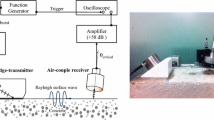Abstract
A one-sided, nondestructive, ultrasonic technique for monitoring the setting and hardening process of concrete has recently been developed. The technique is based on monitoring the reflection coefficient of ultrasonic transverse waves at the surface of a laboratory scale hardening concrete in steel molds. The technique has been shown to reliably estimate the rate of strength gain of concrete under isothermal and outdoor conditions. Results of an experimental study to investigate the influence of curing temperature and mix design on the rate of strength gain and the ultrasonic transverse wave reflection loss are presented in this paper. Simultaneous measurements of wave reflection loss and compressive strength have been performed on various concrete compositions under different curing conditions. The ultrasonic technique is shown to produce reliable estimates of the rate of strength gain at early ages.
Résumé
Une technique de contrôle de la cristallisation du béton a récemment été développée. Cette méthode non destructive et ne requérant qu'une seule surface d'essai est fondéc sur l'étude de la diminution de la réflexion des ultrasons sur la surface du béton en cours de cristallisation. L'influence de la température de cristallisation et de la formulation du béton sur la vitesse de durcissement et l'atténuation de la réflexion des ondes ultrasoniques transversales a été mise en évidence par le biais d'une étude expérimentale dont les résultats sont présentés. La méthodologie de cette étude consiste en la mesure simultanée de la réflexion des ultrasons et de la résistance en compression du béton sous différentes conditions de cristallisation. Il a ainsi été démontré que cette technique de contrôle produisait des estimations fiables de la vitesse de durcissement du béton aux jeunes âges, dans un environnement isotherme comme sous des conditions extérieures.
Similar content being viewed by others
References
Boutin, C. and Arnaud, L., ‘Mechanical characterization of heterogeneous materials during setting’,European Journal of Mechanics, A/Solids 14 (4) (1995) 633–656.
Reinhardt, H.-W., Große, C. and Herb, A., ‘Ultrasonic monitoring of setting and hardening of cement mortar—a new device’,Mater. Struct. 33 (233) (2000) 580–583.
Sayers, C.M. and Grenfell, R.L., ‘Ultrasonic propagation through hydrating cements: onset of shear wave propagation’,Ultrasonics 31 (3) (1993) 147–153.
D'Angelo, R., Plona, T.J., Schwartz, L.M. and Coveney, P., ‘Ultrasonic measurements on hydrating cement slurries’,Advanced Cement Based Materials 2 (1) (1995) 8–14.
Boumiz, A., Vernet, C. and Tenoudji, F.C., ‘Mechanical properties of cement pastes and mortars at early ages, evolution with time and degree of hydration’,Advanced Cement Based Materials 3 (3/4) (1996) 94–106.
Papadakis, E.P., ‘Buffer-rod system for ultrasonic attenuation measurements’,Journal of Acoustical Society of America 44 (5) (1968) 1437–1441.
Stepišnik, J., Lukač, M. and Kocuvan, I., ‘Measurement of cement hydration by ultrasonics’,Ceramic Bulletin 60 (4) (1981) 481–483.
Valič, M.I., ‘Hydration of cementitious materials by pulse echo USWR method, apparatus and application examples’,Cement and Concrete Research 30 (10) (2000) 1633–1640.
Öztürk, T., Rapoport, J., Popovics, J.S. and Shah, S.P., ‘Monitoring the setting and hardening of cement-based materials with ultrasound’,Concrete Science and Engineering 1 (2) (1999) 83–91.
Rapoport, J., Popovics, J.S., Subramaniam, K.V. and Shah, S.P., ‘The use of ultrasound to monitor the stiffening process of portland cement concrete with admixtures’,ACI Materials Journal 97 (6) (2000) 675–683.
Chotard, T., Gimet-Breart, N., Smith, A., Fargeot, D., Bonnet, J.P. and Gault, C., ‘Application of ultrasonic testing to describe the hydration of calcium aluminate cement at the early age’,Cement and Concrete Research 31 (3) (2001) 405–412.
ASTM C 215, 1998, ‘Test method for fundamental transverse, longitudinal, and torsional frequencies of concrete specimens’Annual Book of Standards, Volume 04.02. Concrete and Aggregates’, ASTM, Philadelphia, PA.
Leming, M.L., Nau, J.M. and Fukuda, J., ‘Nondestructive determination of the dynamic modulus of concrete disks’ACI Materials Journal 95 (1) (1998) 50–57.
Mantrala, S.K. and Vipulanandan, C., ‘Nondestructive evaluation of polyester polymer concrte’,ACI Materials Journal 92 (6) (1995) 660–668.
Nagy, A., ‘Determination of E-modulus of young concrete with nondestructive method’,ASCE Journal of Materials in Civil Engineering 9 (1) (1997) 15–20.
Kolluru, S.V., Popovics, J.S. and Shah, S.P., ‘Determining elastic properties of concrete using vibrational resonance frequencies of standard test cylinders’,Cement. Concrete, and Aggregates 22 (2) (2000) 81–89.
Xianyu, J. and Li Z., ‘Dynamic property determination for early-age concrete’,ACI Materials Journal 98 (5) (2001) 365–370.
Carino, N.J., ‘The maturity method: theory and application’,Cement, Concrete, and Aggregates 6 (2) (1984) 61–73.
Keating, J., Hannant, D.J. and Hibbert, A.P., ‘Correlation between cube strength, ultrasonic pulse velocity and volume change for oil well cement sluries’,Cement and Concrete Research 19 (5) (1989) 715–726.
Pessiki, S.P. and Carino, N.J., ‘Setting time and strength of concrete using the impact-echo method’,ACI Materials Journal 85 (5) (1988) 389–399.
Popovics, J.S., Song, W., Achenbach, J.D., Lee, J.H. and Andre, R.F., ‘One-sided wave velocity measurement in concrete’,Journal of Engineering Mechanics 124 (12) (1998) 1346–1353.
Subramaniam, K.V., Mohsen, J.P., Shaw, C.K. and Shah, S.P., ‘An ultrasonic technique for monitoring concrete strength gain at early age’,ACI Materials Journal 99 (5) (2002) 458–462.
Popovics, S., ‘Analysis of the concrete strength versus ultrasonic pulse velocity relationship’,Materials Evaluation 59 (2) (2001) 123–129.
Author information
Authors and Affiliations
Additional information
Editorial Note Prof. Dr. Surendra P. Shah is a RILEM Senior Member and a member of the Bureau of RILEM as well as the Editor-in-Chief ofMaterials and Structures. Dr. Y. Akkaya, Dr. K.V. Subramaniam and Prof. S.P. Shah participate in RILEM TC 185-ATC ‘Advanced testing of cement-based materials during setting and hardening’. Prof. Shah also participates in RILEM TC SOC ‘Experimental determination of the stress-crack opening curve for concrete in tension’. ACBM Center (Northwestern University) is a RILEM Titular Member.
Rights and permissions
About this article
Cite this article
Akkaya, Y., Voigt, T., Subramaniam, K.V. et al. Nondestructive measurement of concrete strength gain by an ultrasonic wave reflection method. Mat. Struct. 36, 507–514 (2003). https://doi.org/10.1007/BF02480827
Received:
Accepted:
Issue Date:
DOI: https://doi.org/10.1007/BF02480827




